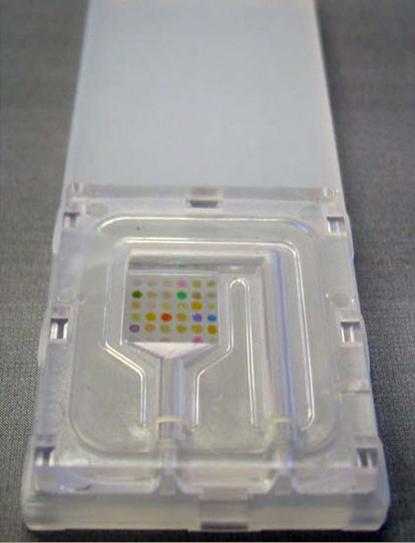Imagine a postage stamp capable of "sniffing" and detecting poisonous gases or deadly toxins simply by changing its color.

As published in September in the scientific journal Nature Chemistry, scientist Kenneth Suslick and his research team at the University of Illinois have developed an artificial nose for detecting toxic industrial substances, a device that is simple, fast and cheap - and works by visualizing odors. This detection system could be effective in detecting high exposure levels of substances that pose serious health risks in the workplace or during industrial accidents.
"Our device is basically a digital multidimensional extension of litmus paper. We have a data set of six rows by six columns of different nanoporous dyes that change their color depending on their chemical environment," explains the researcher. "The color change pattern is like a unique molecular fingerprint for each toxic gas and its exact concentration in the sample. By comparing the pattern to a known library of color fingerprints, the presence of a toxic industrial substance can be located and quantified within seconds."
In order to prepare the array, the researchers imprinted a series of painted dots - each containing a different color (pigment) - on an inactive substrate such as paper, plastic or glass. After that, the array is digitally (digitally) scanned by a standard desktop scanner or a digital camera before and after exposure to the "fragrance" producing material. Additionally, unlike other previously tested electronic nose technologies, these color sensors are not sensitive to changes in relative humidity.
While physicists have radiation detection tags that protect them in the workplace, chemists and other workers dealing with chemicals (the paint and cosmetics industries for example) have no effective equivalent for monitoring their exposure to toxic chemicals.
"The current research is an essential part of a larger project, which aims to develop cutting-edge technologies for monitoring and a better understanding of health risks as a result of exposure to gases in the air," explains one of the researchers. "This paper moves us one step closer to making a tiny wearable sensor capable of detecting a large number of different airborne toxins."
In order to test the applicability of their color sensing array, the researchers selected nineteen representative samples of toxic industrial chemicals, such as: ammonia, chlorine, nitric acid and sulfur dioxide in concentrations known to be immediately life or health threatening.
In the laboratory experiments, an inexpensive desktop scanner was used to run the method. The researchers developed a fully functional, handheld prototype device that uses cheap light-emitting diode (LED) white radiation and a typical camera to make the entire scanning process more sensitive, tiny, faster and cheaper. In the future, the researchers hope, the device will be similar to a card scanning device. The facility is currently undergoing licensing and commercialization processes by the iSense company, located in Palo Alto, California, USA.
The researchers point out that previous methods were based on sensors whose response resulted from very weak and non-specific chemical interactions, while the current method is based on stronger dye-reagent interactions obtained from an extensive group of chemicals. The ability of this sensor to detect such a large number of volatile toxins lies in the increased range of correlations used to differentiate the detector's response. "One of the nice things about this method lies in the fact that the most available and inexpensive ingredients are used," adds one of the researchers. "In light of the wide range of chemicals that can be detected and the high sensitivity of the device to these substances, it seems that it could be extremely useful in the various work environments."
